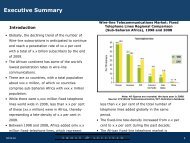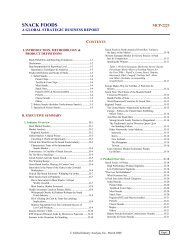the RUSSIA oil & gas competitive intelligence report - Report Buyer
the RUSSIA oil & gas competitive intelligence report - Report Buyer
the RUSSIA oil & gas competitive intelligence report - Report Buyer
Create successful ePaper yourself
Turn your PDF publications into a flip-book with our unique Google optimized e-Paper software.
Russia Oil and Gas Competitive Intelligence <strong>Report</strong> 2010<br />
Market Position<br />
Gazprom Neft was founded as Sibneft in 1995 and took on a broad portfolio of former state assets.<br />
Following two failed merger attempts with Yukos in September 2005, Gazprom acquired 72% in Sibneft,<br />
buying out businessman Roman Abramovich’s stake in a US$13bn deal, raising its stake to 95.7% after<br />
exercising its buy-out right in April 2009. The company was <strong>the</strong>n renamed Gazprom Neft. It is now <strong>the</strong><br />
fifth largest crude producer in Russia and has one of <strong>the</strong> best growth rates, owing to its strong position in<br />
high-potential regions. Gazprom Neft’s upstream assets are chiefly located in <strong>the</strong> Northwest and Western<br />
Siberia (Yamal-Nenets, Khanty-Mansiysk, Omsk, Tomsk, Tiumen), as well as Irkutsk and Chukotka<br />
fur<strong>the</strong>r east. The main production arm is Noyabrskneftegaz, which operates about 30 fields in <strong>the</strong><br />
Yamal-Nenets and Khanty-Mansiysk autonomous regions and holds around 60% of <strong>the</strong> company’s<br />
reserves.<br />
O<strong>the</strong>r major producing assets include stakes in Slavneft and Tomskneft, jointly owned with TNK-BP and<br />
Rosneft respectively. As of Q309 Gazrpom Neft also has managerial control of Sibir Energy, which it<br />
won after significant effort. Sibir's upstream operations are focused on Khanty-Mansiysk where it holds<br />
<strong>the</strong> Salym fields, operated on a 50:50 basis with Shell, and <strong>the</strong> Yuzhnoe and Orekhovskoe fields, operated<br />
by subsidiary Magma Oil (95%). In 2009, Sibir’s net output averaged around 80,000b/d.<br />
Gazprom Neft’s refining and market assets include <strong>the</strong> 385,000b/d Omsk Refinery and a 60% vote in <strong>the</strong><br />
240,000b/d Moscow Oil Refinery, as well as a growing network of service stations primarily located in<br />
Western Siberia, although Sibir’s acquisition has given it a strong position in Moscow. Through its<br />
wholly owned unit Moscow Oil and Gas Company (MOGC), Sibir owns 100% of 69 MKT-branded<br />
service stations, 51% of Mosnefteproduct's 64 stations and storage terminals and 25% of BP's Moscow<br />
retail network.<br />
Strategy<br />
The company is involved in <strong>the</strong> planned 1mn b/d Bur<strong>gas</strong>-Alexandroupolis pipeline, which will transport<br />
Russian crude to Europe and is preliminarily scheduled for completion in 2010. Gazprom Neft also works<br />
on <strong>the</strong> Nor<strong>the</strong>rn Zadegan project in Iran.<br />
Gazprom Neft plans to produce 1.8mn b/d by 2020 through developing Arctic fields and investing<br />
US$70bn. Gazprom Neft expects to receive <strong>the</strong> licence to develop <strong>the</strong> Arctic Prirazlomnoye deposit by<br />
2010 and plans to start work at <strong>the</strong> giant offshore field five years later. Downstream, <strong>the</strong> company plans<br />
to raise refining capacity until it accounts for two-thirds of crude production. It will achieve this goal by<br />
purchasing refineries at home and abroad, and is particularly interested in buying more European assets<br />
after in February 2009 acquiring 51% of Serbia’s Naftna Industrija Srbije (NIS).<br />
© Business Monitor International Ltd Page 30









